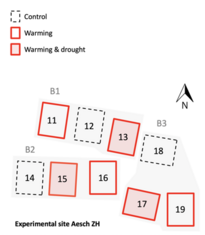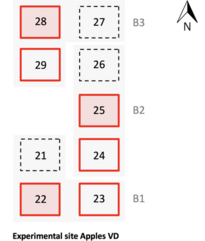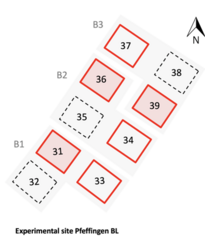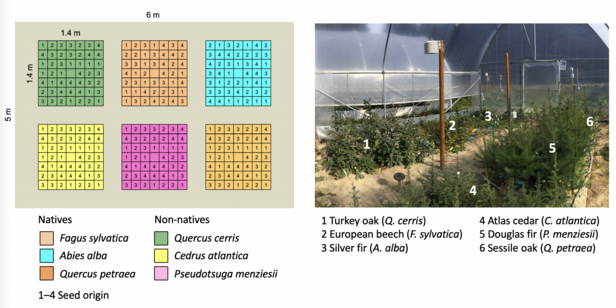Polytunnel Greenhouse Experiment
Yann Vitasse
Beat Frey
Martin Gossner
Frank Hagedorn
Martina Peter
Anita Christina Risch
Thomas Wohlgemuth
Stephan Zimmermann
Charlotte Grossiord
Esther Frei
Daniel Scherrer
2021 - 2030
CooperationImpact of climate smart forests on ecosystem functioning and diversity
We study how rising temperatures and increasing drought (‘hotter drought’) will affect the growth of potential future tree species during the advanced regeneration stage (2–8 years-old plants) and how this response is modulated by soil properties and soil biotic communities.
Background and aims
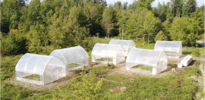
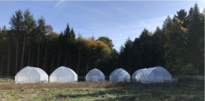
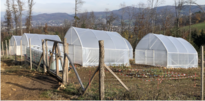
High temperatures combined with extended drought periods (‘hotter drought’), complemented by repeated windthrow disturbance (e.g. storms ‘Burglind’ in January 2018 or ‘Sabine’ in February 2020) and bark beetle mass propagation have left their marks on Swiss lowland forests, particularly in the Jura and the north-eastern Plateau. Both Picea abies, the economically most important tree in Central Europe, as well as Fagus sylvatica, so far considered as a suitable future tree species, have suffered from exceptional mortality. This pinpoints the importance and the timeliness of the search for a future tree species portfolio that will satisfy not only economic aspects of forestry, but also the global quest for carbon storage, regional demands of ecosystem functions and services and biodiversity conservation (‘climate smart forestry’). Planting non-native tree species has a long tradition in forestry, but ideas of transforming Central European forests for climate smart forestry by assisting the migration of exotic species get little support from nature conservancy. Although there is increasing knowledge about the invasiveness of individual tree species, there are only a few studies addressing impacts of assisted tree migration on the local flora, fauna and other biota as well as on species interactions and related ecosystem processes. In particular, information is missing on how non-natives will interact with native species under future climatic conditions, how these interactions are modulated by soil properties, or how they will affect – or be affected by – soil biotic communities and soil biogeochemical processes.
Experimental set-up
The Polytunnel Greenhouse Experiment includes three experimental sites on the Swiss Plateau, where air temperature and precipitation are manipulated by means of polytunnel greenhouses from 2021–2029. The three sites are part of a larger network of Experimental Plantations by WSL and BAFU, where 18 potential future tree species are grown at 59 sites across Switzerland.
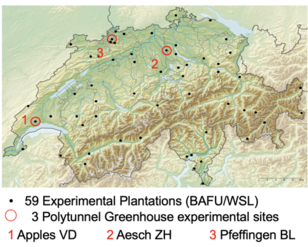
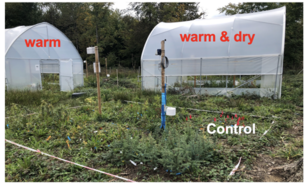
Tree species
In the Polytunnel Greenhouse Experiment, seedlings of native beech (Fagus sylvatica), sessile oak (Quercus petraea), and silver fir (Abies alba) are grown alongside Douglas fir (Pseudotsuga menziesii), Atlas cedar (Cedrus atlantica), and Turkey oak (Quercus cerris), three species that are non-native to the Swiss Plateau. For each species, seeds of four different origins were used to grow seedlings in a nursery in Switzerland. The 2-yrs-old seedlings were transplanted to the experimental sites in autumn 2021.
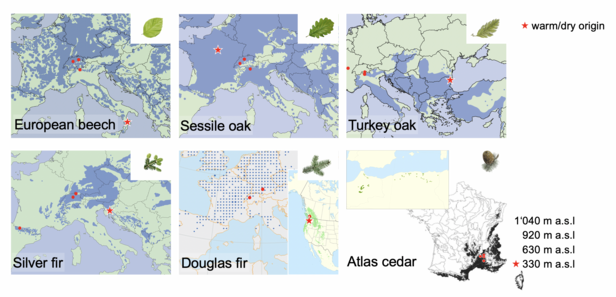
Climate manipulation treatments
Climate treatments include control plots, plots with warming and plots with combined warming and drought. The passive warming by the polytunnels reaches 2–5°C during daytime (0.1°C during the night). By intercepting ambient rainfall, the greenhouses also provide a drought treatment. A drip irrigation system is run weekly to add ambient rainfall to one half of the greenhouses, and 50% of ambient rainfall to the other half.
The following environmental parameters are continuously monitored: at each site (1) local precipitation (Atmos All-in-One weather station); in each plot (2) air temperature and relative humidity at 2m, 0.5m above ground (Hobo MX2301 sensors), (3) volumetric soil water content and soil temperature (TOMST TMS4 sensor), and (4) photosynthetically active radiation (Apogee PAR Quantum sensor SQ-421-SS). Annual tree height measurements and soil analyses are provided by the research group Plant Regeneration Ecology, which is responsible for running the experiment.
Experimental design
The experimental set-up consists of a fully randomised block design replicated three times at each site. Each block includes three plots with the following treatments
-
Untreated control plot with ambient temperature and precipitation (no greenhouse, no watering)
-
Warmed plot with elevated temperature and ambient precipitation (greenhouse, 100% of ambient precipitation added by drip irrigation)
-
Warm & dry plot with elevated temperature and reduced precipitation (greenhouse, 50% of ambient precipitation added).
Each plot contains six sub-plots, one for each tree species. Each sub-plot is divided into quadrats of 20 cm x 20 cm, each of which was planted with one tree at the beginning of the experiment. With this rather narrow spacing, 48 trees were planted per sub-plot/species, half of which will be available for destructive harvesting by the end of 2024. To account for the genetic variation of a species, plants of four different provenances were planted for each species, i.e. each sub-plot contains 12 plants per provenance. Species are described in Table 2, provenances are shown in Fig. 4. Overall, the experiment contains 36 replicate trees per site x treatment x species x provenance, i.e. a total of 2'592 plants per site. Treatments, species and provenances were randomly assigned to plots within blocks, sub-plots within plots, and quadrats within sub-plots, respectively.
Projects
- Schränkt Frost das Baumartenportfolio der Zukunft ein? (Effects of late frost on the future tree species portfolio) - funded by Ernst Göhner Stiftung
Team
- Yann Vitasse, Beat Frey, Martin Gossner, Frank Hagedorn, Martina Peter, Anita Risch, Thomas Wohlgemuth, Stephan Zimmermann, WSL;
- Charlotte Grossiord, WSL/ETH Lausanne;
- Jaboury Ghazoul, ETH Zürich;
- Günter Hoch, Universität Basel
